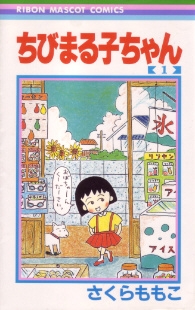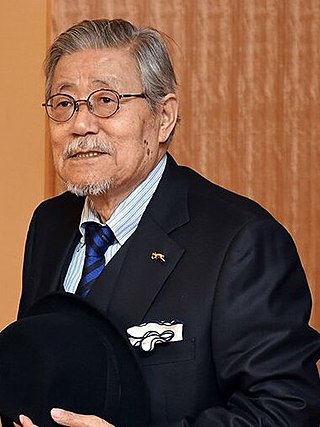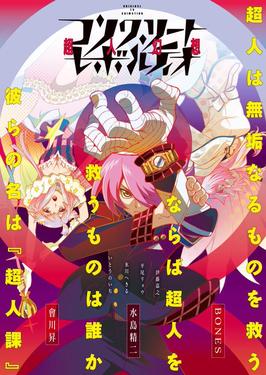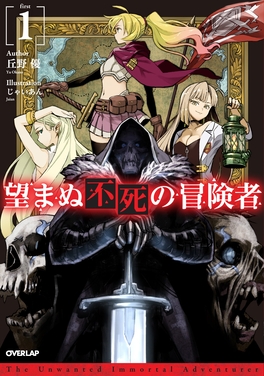1, Hepburn: Baromu Wan) is a Japanese manga series written by Takao Saito. The original story was serialized for about a year from 1970 in Kodansha's Weekly Bokura Magazine . It was available online in English through JManga. [3]
Contents
In 1972, the manga was adapted into a TV tokusatsu series titled Chōjin Barom-1 (超人バロム・1) by Toei, and broadcast by Yomiuri TV every Sunday 19:30–20:00 from April 2 to November 26. In this TV series, the original story and character designs by Saito were widely changed.
During the airing seasons of the tokusatsu series; due to the naming of the villain character Doruge (ドルゲ, Doruge), a German child studying in Japan with a similarly sounding surname was bullied by native schoolmates - which was led to be mentioned in the newspaper in August 25 (four months later from the airing of the first episode) and also led the series to be aired further with the notice; "The fictional character Doruge has no relation with living people."
An anime version was created and broadcast from December 2002 to March 2003 by AT-X. In this version the plot and story were also changed from its original version.
Plot
One night, a monster comes out from a lake and starts attacking Takeshi Kido and Kentaro Shiratori, childhood friends who were born on the same day. When the monster is about to kill both of them, a being called Kopu calls and tells them that they are the chosen ones to protect the world from the evil creature Doruge. [4] Kopu gives a radar to Kentaro and Takeshi and the ability to transform into the powerful monster Barom-1 by joining their hands. Now both boys must destroy the monsters possessed by Doruge.
References to Barom-1 in other media
In Battle Royale manga during Yumiko Kusaka and Yukiko Kitano's flashbacks in the second volume (Shuuya Nanahara illustrates a point by mentioning the two main characters of the story).
After having their bodies swapped, Excel and Hyatt from Excel Saga return to normal after Nabeshin's instructions to fuse themselves as a monster that is very similar to Barom-1 (even Excel says she wanted to be Takeshi).
Related Research Articles
Takeshi Obata is a Japanese manga artist that usually works as the illustrator in collaboration with a writer. He first gained international attention for Hikaru no Go (1999–2003) with Yumi Hotta, but is better known for Death Note (2003–2006) and Bakuman (2008–2012) with Tsugumi Ohba. Obata has mentored several well-known manga artists, including Nobuhiro Watsuki of Rurouni Kenshin fame, Black Cat creator Kentaro Yabuki, and Eyeshield 21 artist Yusuke Murata.

Chibi Maruko-chan is a manga series written and illustrated by Momoko Sakura. The series depicts the simple, everyday life of Momoko Sakura, a young girl everyone calls Maruko, and her family in suburban Japan in the year 1974. Maruko is a troublemaker, and every episode recounts Maruko's trouble and how she and her friends succeed in solving the situation. The series is set in the former of Irie District (入江町), Shimizu, now part of Shizuoka City, birthplace of its author.

Denkou Choujin Gridman, known as Gridman the Hyper Agent in some English-speaking territories, is a 1993–1994 Japanese tokusatsu "Giant Hero" series created by Tsuburaya Productions and would be Tsuburaya's last non-Ultra superhero production before Bio Planet WoO. It was the inspiration and source material for DiC Entertainment's Superhuman Samurai Syber-Squad.
Yabuki is a Japanese surname and place name. It may refer to:

Takao Saito was a Japanese manga artist, although he rejected the term and considered his work gekiga. He was best known for Golgo 13, which has been serialized in Big Comic since 1968, making it the oldest manga still in publication. Golgo 13 holds the Guinness World Record for "Most volumes published for a single manga series" and, in accordance with Saito's wishes, it continues to be serialized following his death from pancreatic cancer in September 2021. Saito won several awards in his 66-year career, including the Shogakukan Manga Award twice, and received the Medal with Purple Ribbon and Order of the Rising Sun from the Japanese government for his contributions to the arts.

Doraemon is the most recent anime television series based on Fujiko F. Fujio's manga of the same name. Produced by Shin-Ei Animation, TV Asahi and ADK Emotions, it began airing on all ANN stations on April 15, 2005. It also airs in over 50 countries worldwide.

Muteking, The Dashing Warrior is an anime television series produced by Tatsunoko Productions for Fuji TV. It ran from September 7, 1980, to September 27, 1981.
Kido is a Japanese surname.

Your Lie in April is a Japanese romantic drama manga series written and illustrated by Naoshi Arakawa. It was serialized in Kodansha's magazine Monthly Shōnen Magazine from April 2011 to February 2015. The story follows a young pianist named Kо̄sei Arima, who loses the ability to perform the piano after his mother's death, and his experiences after he meets violinist Kaori Miyazono.

Concrete Revolutio: Superhuman Phantasmagoria is a Japanese superhero anime television series created and written by Shō Aikawa, directed by Seiji Mizushima, produced by Bones, and featuring character designs by Yoshiyuki Ito. It began airing in Japan in October 2015. A second season debuted on 3 April 2016.

Holmes of Kyoto is a Japanese mystery novel series written by Mai Mochizuki and illustrated by Shizu Yamauchi. Futabasha have published twenty-three volumes since April 2015. A manga adaptation with art by Ichiha Akizuki has been serialized in Futabasha's seinen manga magazine Monthly Action from December 2017 to February 2024, later transferring to Web Action. It has been collected in thirteen tankōbon volumes. An anime television series adaptation by Seven aired from July 9 to September 24, 2018, on TV Tokyo.

Maesetsu!: Opening Act (まえせつ!) is an original Japanese anime television series co-animated by Studio Gokumi and AXsiZ. The series aired from October to December 2020, while a manga adaptation by Hato Kannazuki was serialized from July 2020 to May 2021 in Monthly Comic Alive.

Peach Boy Riverside is a Japanese manga series written and illustrated by Coolkyousinnjya, serialized on Neetsha's webcomic distribution site Weekly Young VIP since January 2008. The remake version written by Coolkyousinnjya and illustrated by Johanne has been serialized in Kodansha's shōnen manga magazine Shōnen Magazine R, as well as the website and app Magazine Pocket, since August 2015 and has been collected in fifteen tankōbon volumes. The remake is set to end with the release of its sixteenth volume. The manga is licensed in North America by Kodansha USA. An anime television series adaptation produced by Asahi Production aired from July to September 2021.

Oblivion Battery is a Japanese manga series written and illustrated by Eko Mikawa. It has been serialized via Shueisha's online manga app Shōnen Jump+ since April 2018, and has been collected in 17 tankōbon volumes as of January 2024. An original net animation (ONA) adaptation produced by MAPPA streamed in October 2020 as part of the Jump Special Anime Festa 2020 online event. An anime television series, also by MAPPA, aired from April to July 2024.

Choujin X is a Japanese manga series written and illustrated by Sui Ishida. It has been irregularly serialized on Shueisha's Tonari no Young Jump website since May 2021 and in Weekly Young Jump from October 2021 to February 2022.

Black Summoner is a Japanese light novel series written by Doufu Mayoi. It began publication online on the Shōsetsuka ni Narō novel posting website in October 2014. Overlap began publishing the series with illustrations by Kurogin under their Overlap Bunko imprint in June 2016. A manga adaptation with illustrations by Gin Ammo began serialization in Overlap's Comic Gardo website in January 2018. An anime television series adaptation by Satelight aired from July to September 2022.

The Unwanted Undead Adventurer is a Japanese light novel series written by Yū Okano and illustrated by Jaian. It has been serialized online via the user-generated novel publishing website Shōsetsuka ni Narō since September 2016. It was later acquired by Overlap, who have published thirteen volumes since October 2017 under their Overlap Novels imprint.

Tonbo! is a Japanese manga series written by Ken Kawasaki and illustrated by Yū Furusawa. It has been serialized in Golf Digest's golfing magazine Weekly Golf Digest since August 2014. An anime television series adaptation produced by OLM aired from April to June 2024. A second season premiered in October of the same year.
References
- ↑ "9/15(土)AM10時~13時 強化稽古!!:友情のバロムクロス???". kuranari.blog37.fc2.com. Retrieved May 8, 2014.
- ↑ "バンダイ ソフビ魂 Vol−11超人バロム1 エネルギーダウン初期Ver". rakuten.co.jp. Archived from the original on March 4, 2016. Retrieved October 19, 2016.
- ↑ "Barom". Archived from the original on January 27, 2013. Retrieved October 10, 2016.
- ↑ "グロキモい (4)". rakuten.co.jp. Archived from the original on March 4, 2016. Retrieved October 19, 2016.
External links
- Barom One (manga) at Anime News Network 's encyclopedia
- Barom One (anime) at Anime News Network 's encyclopedia
| Barom-1 | |
 Cover of Barom One volume 1 as re-edited in May 1998 | |
| バロム・1 (Baromu wan) | |
|---|---|
| Genre | Supernatural, Science fiction, Superhero |
| Original network | AT-X |
| Original run | December 7, 2002 – March 22, 2003 |
| Episodes | 13 |
| | This manga-related article is a stub. You can help Wikipedia by expanding it. |